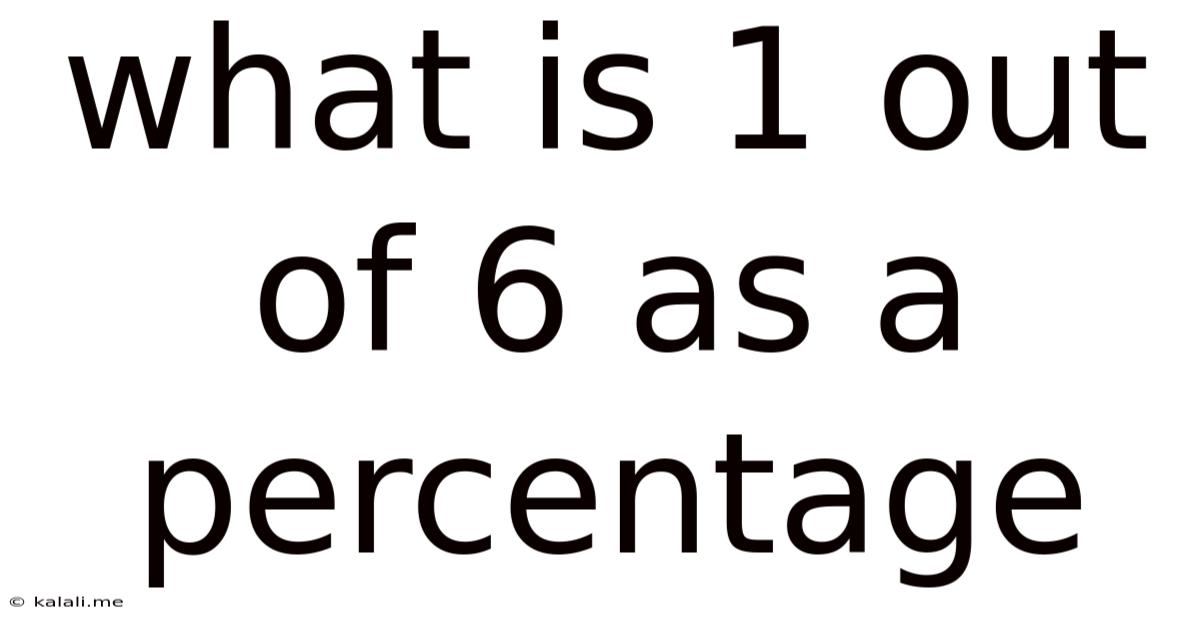What Is 1 Out Of 6 As A Percentage
Kalali
Apr 18, 2025 · 4 min read

Table of Contents
What is 1 out of 6 as a Percentage? A Comprehensive Guide to Fractions, Decimals, and Percentages
Knowing how to convert fractions to percentages is a fundamental skill applicable across various fields, from everyday budgeting to complex statistical analysis. This comprehensive guide will not only answer the question "What is 1 out of 6 as a percentage?" but also delve deeper into the underlying concepts, providing you with the tools to tackle similar conversions with ease. Understanding this seemingly simple calculation opens doors to a better grasp of proportional reasoning and data interpretation.
Understanding Fractions, Decimals, and Percentages
Before jumping into the specific calculation, let's establish a clear understanding of the three core concepts: fractions, decimals, and percentages. They are all different ways of representing parts of a whole.
-
Fractions: Fractions represent a part of a whole using a numerator (the top number) and a denominator (the bottom number). The numerator indicates how many parts you have, and the denominator indicates how many equal parts the whole is divided into. For example, 1/6 represents one part out of six equal parts.
-
Decimals: Decimals represent parts of a whole using the base-10 number system. The decimal point separates the whole number from the fractional part. For example, 0.5 represents one-half (1/2).
-
Percentages: Percentages represent parts of a whole as a fraction of 100. The "%" symbol indicates that the number is a percentage. For example, 50% represents 50 parts out of 100, which is equivalent to 1/2 or 0.5.
Calculating 1 out of 6 as a Percentage
Now, let's tackle the main question: What is 1 out of 6 as a percentage? We can solve this using two primary methods:
Method 1: Direct Conversion
This method involves directly converting the fraction 1/6 into a percentage. The process is as follows:
-
Divide the numerator by the denominator: Divide 1 by 6. This gives you 0.166666... (a repeating decimal).
-
Multiply by 100: Multiply the result from step 1 by 100 to express it as a percentage. 0.166666... x 100 = 16.6666...%
-
Round to the desired precision: Depending on the context, you can round the percentage to a certain number of decimal places. Rounding to two decimal places, we get 16.67%.
Therefore, 1 out of 6 is equal to 16.67%.
Method 2: Using Proportions
This method utilizes the concept of proportions to solve the problem. We can set up a proportion to find the equivalent percentage:
1/6 = x/100
Where 'x' represents the percentage we're trying to find. To solve for 'x', we cross-multiply:
1 * 100 = 6 * x
100 = 6x
x = 100/6
x = 16.6666...
Again, multiplying by 100 and rounding to two decimal places gives us 16.67%.
Practical Applications of Percentage Conversions
Understanding how to convert fractions to percentages has numerous practical applications in various aspects of life:
-
Finance: Calculating interest rates, discounts, tax rates, profit margins, and more. For instance, if a store offers a discount of 1 out of 6 on an item, you know it's a 16.67% discount.
-
Statistics: Analyzing data, interpreting survey results, and representing proportions within larger datasets. Understanding percentages allows for easy comparison of different proportions.
-
Science: Expressing experimental results, calculating probabilities, and representing data in graphical formats.
-
Everyday Life: Calculating tips, splitting bills, understanding sales, and interpreting various proportions encountered daily.
Beyond the Basics: Working with More Complex Fractions
The methods described above can be applied to any fraction. Let's look at a few examples:
-
2 out of 6 as a percentage: (2/6) * 100 = 33.33%
-
3 out of 6 as a percentage: (3/6) * 100 = 50% (This simplifies to 1/2, which is 50%)
-
5 out of 6 as a percentage: (5/6) * 100 = 83.33%
Notice that these percentages, when added together (16.67% + 33.33% + 50% + 83.33%), will approximately equal 100%, reflecting the whole. This is a useful check to ensure your calculations are accurate.
Dealing with Repeating Decimals
As you've seen, converting fractions like 1/6 often results in repeating decimals. It's crucial to understand how to handle these:
-
Rounding: Rounding to a suitable number of decimal places provides a practical approximation. The level of precision required depends on the context. For most everyday purposes, two decimal places are sufficient.
-
Exact representation: For precise calculations, it's often better to leave the number as a fraction or use the full repeating decimal, especially in scientific or engineering applications where accuracy is paramount. Software programs often handle repeating decimals more precisely than manual calculations.
Mastering Fraction to Percentage Conversions
Becoming proficient in converting fractions to percentages is a valuable skill that enhances your numerical literacy and problem-solving abilities. By understanding the underlying principles and practicing the methods outlined in this guide, you can confidently tackle various percentage calculations, simplifying complex tasks and improving your overall understanding of quantitative data. Remember, practice is key – the more you work with fractions and percentages, the easier and more intuitive the process will become. So, grab a calculator, try out different fractions, and strengthen your mathematical prowess. The ability to quickly and accurately perform these conversions will prove beneficial in countless situations.
Latest Posts
Latest Posts
-
What Percent Of 300 Is 50
Apr 20, 2025
-
How Many Cups Equal 15 Oz
Apr 20, 2025
-
1 Pint Is How Many Milliliters
Apr 20, 2025
-
16 Over 5 As A Mixed Number
Apr 20, 2025
-
What Is 114 Cm In Inches
Apr 20, 2025
Related Post
Thank you for visiting our website which covers about What Is 1 Out Of 6 As A Percentage . We hope the information provided has been useful to you. Feel free to contact us if you have any questions or need further assistance. See you next time and don't miss to bookmark.